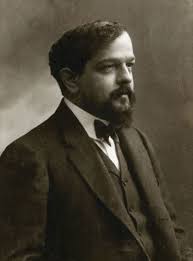
It’s always a blissful coincidence when a piano teacher discovers a wealth of contemporary commentary about a composer whose music is under study in a partnered learning environment. With a framing introduction about the creator, a mentor and pupil can journey beyond details of notation, fingering, harmony, to absorb context, history, and varying compositional approaches to a vast repertoire.
Within this expanded universe of knowing, Stephen Hough, pianist, has written a detailed article about Debussy and his Modernist status among composers who preceded and followed him. Amidst the writer’s many crafted lines about Debussy in this “new” light, a few are fleshed out as companion to playing samples. (linked within the NYT text)
“No other composer feels to me more improvised, more free-flowing. But then the player is conscious of a contradiction as the score is studied more closely: Music that sounds created in the moment is loaded with instructions on how to achieve this.”
Hough refuses to stereotype Debussy with superficial claims about whole tone scales and water motifs. Instead, he carefully sifts through various compositions to support his individually tailored analyses.
In Pagodes from Estampes the pianist emphasizes the composer’s exposure to Javanese gamelan music at a Paris Exposition in 1889. “A Newly learned, fully absorbed language” is imbued with a pentatonic scale that creates a “color” dimension.
In the universe of tactile “feel,” Hough waxes poetic:
“…this is music made as molded by playing, as dough is folded with yeast to create bread. As the fingers reach the keys, sound and touch seem to fuse into one. The keyboard has ceased to be a mere function for hammers to strike strings, and has become a precious horizontal artifact to caress. This is music of the piano as much as for the piano. The poet Léon-Paul Fargue, having watched Debussy play, wrote that he “would start by brushing the keys, prodding the odd one here and there, making a pass over them and then he would sink into velvet.”
Images
“Debussy’s piano music is perfectly conceived for the instrument. But it isn’t just that it fits beautifully under the hand or sounds wonderful as the vibrations leave the soundboard and enter the ear. To play the opening of “Reflets dans l’Eau” (from “Images,” Book One) feels as if the composer has transplanted his fingerprints onto the pads of your digits. The way the chords are placed on the keys (flat-fingered on the black notes) is not so much a vision of reflections, whether trees, clouds or water lilies. It is as if each three-padded triad is an actual laying of a flower onto the water’s surface.”
A pertinent New York Times feature highlighting “The Week’s Best Classical Music Moments on YouTube,” includes the performance of Arturo Benedetti Michelangeli playing both books of “Images.”
The Times reviewer supplements Hough’s Debussy analysis with his own comments: “Painterly colors and milky textures are requisite, of course. But details matter in Debussy.” Tommasini sees “rhythm and the use of rubato as intrinsic to the playing.” It’s Michelangeli’s use of rubato that shines through for him.
In the realm of rubato and musical expression, Hough chimes reflects about the music of Chopin as it relates to Debussy: “I think the secret to playing Debussy’s music lies in its Chopinist roots — he edited the Polish composer’s works for Durand — and in his ties to his older, old-fashioned compatriots Massenet, Delibes and others.”
These comments do not detract from paragraphs that Hough includes about the “jazz” inferences of Debussy as they appear in “Golliwog’s Cakewalk,” and “Minstrels.”
But the writer returns to the fold of “Romantic sentimentality” by citing “Clair de Lune” and the “Deux Arabesques” as emblematic.
***
In the pedagogical realm, Graham Fitch, pianist, author and teacher has posted a valuable practicing resource for those learning The Girl with the Flaxen Hair, La Fille Aux Cheveux de Lin.
http://www.practisingthepiano.com/the-girl-with-the-flaxen-hair/
Fitch has a timely introduction to the work:
“The title ‘La Fille aux Cheveux de Lin’ came from Leconte de Lisle’s poem by the same name, included in the Chansons ecossaises (Scottish Songs) from 1852. In this, the eighth piece from the first book of Préludes composed around 1910, Debussy is painting a picture of an innocent and naive Scottish girl. He uses conventional diatonic harmony blended in with pentatonic scales, modal cadences as well as parallel chord movement.”
Fitch adds Debussy’s own riveting comments about pedaling:
“Pedaling cannot be written down. It varies from one instrument to another, from one room, or one hall, to another.”
***
Daniel Barenboim has produced a series of you tube videos that explore various aspects of the Debussy’s music. These are delivered in short segments of commentary and interspersed playing samples. At the fore, Barenboim asserts that Debussy was more influenced by literature and nature than by a school of painting known as Impressionism. (a common cliche that doesn’t hold much water)
Barenboim on Clair de Lune
***
Finally, one of my favorite performances of “Moonlight” rendered by pianist, Seong-Jin Cho
from Arioso7's Blog (Shirley Kirsten)
https://arioso7.wordpress.com/2018/03/10/debussy-framed-articles-and-videos-enrich-our-study/
No comments:
Post a Comment